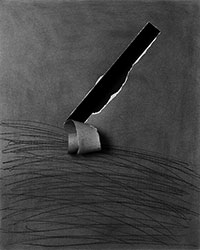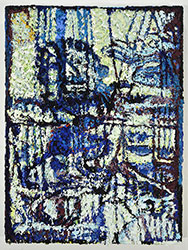September 8 - October 13, 2018
Reception: Saturday, September 8, 5-7PM
A native of Oklahoma, Jerry McMillan moved west in 1958 with childhood friends Ed Ruscha and Joe Goode. The three of them (and others) lived together while attending Chouinard Art Institute in Southern California. McMillan quickly became a key figure in the development of photo-sculpture and, in fact, his folded photo-box entitled Patty as Container 1963, is considered the first photo-sculpture. Walter Hopps organized McMillan's first solo exhibition at the Pasadena Art Museum in 1966, and in 1970, his work was included in the seminal exhibition, Photography into Sculpture at MOMA, curated by Peter Bunnell. In addition to this artistic practice, McMillan revolutionized the art of photographing artists for exhibition announcements, magazine ads and other conceptual applications. His photograph of Ed Ruscha in bed with two women in 1967 became an iconic ad in Artforum with the caption, "Ed Ruscha Says Goodbye to College Joys," and his photo of Judy Chicago in a boxing ring in 1970 was his personification of her toughness in the midst of a male-dominated art scene. These images were included in an exhibition, Jerry McMillan: The Artist's Image at Craig Krull Gallery in 2011 and demonstrated McMillan's key role in creating an artist's persona and shaping how they were perceived. McMillan's photo archives in this genre are now housed at the Getty Research Institute.
The current exhibition continues McMillan's interest in the fundamental properties of photography. While the new work appears to be paper sculpture or even trompe l'oeil, it actually manifests what McMillan calls "the invisible space" of photography. These works are not intended to be considered photographs of another object, or even contain subject matter. In flattening the existing three-dimensional space to two-dimensional, McMillan believes that "the camera is used to reduce the space only; there is no subject matter except space - the camera has no other function, except to add its own particular kind of unique space to this already abstract spatial problem."
A retrospective of Jerry McMillan's work was presented at Cal State Northridge during Pacific Standard Time in 2012.
Concurrently, we are pleased to present Keenan Derby's first solo exhibition at Craig Krull Gallery, entitled Waveforms. This series of paintings was inspired by a 17th century ceramic tile depicting the expedition of a Dutch whaling party, which Derby found in "Secrets of the Sea", a 1971 copy of Reader's Digest. "I was immediately drawn to the luminous blues and whites, and the complex and elegant lines tracing ships, waves, and whalers." The tile's lines serve as the foundation of Derby's paintings, moving in and out of focus as he adds thick, shimmering, coats of acrylic and sand. "The work is finished when the layers of opacity begin to glow with an inner light, and the paint functions on its own terms."
In addition to cool, rocky, ocean waves, Derby is inspired by the warm, hazy, vistas of Southern California. These paintings hug the surface close, lines of paint seeping into an ochre desert of raw linen. Just as the mast of a ship might appear, bobbing, in the thick paintings, here cacti and ancient pines glimmer, like a mirage, within the flat weave of the surface. "Flanking perception and invention, a finished work is a moment cast in stone, a flawed memory solidified into reality, asserting its own place in the world."

